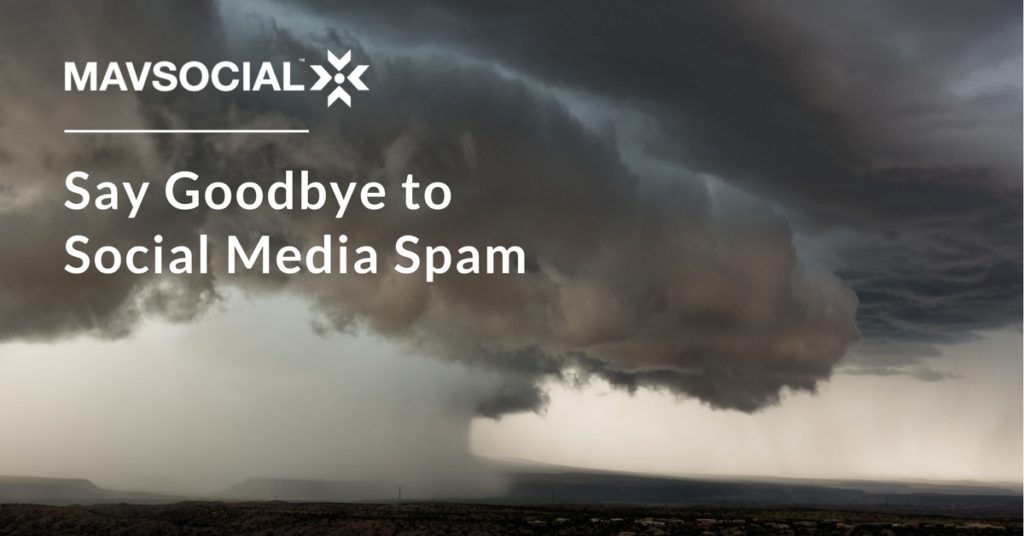One of the biggest challenges brands have today is staying on top of multiple social media platforms.
While social media scheduling platforms such as MavSocial makes this task a whole lot easier, there’s one thing that continues to plague every marketer.
And that one thing is social media spam.
Whether it’s fake followers, spammy comments, or unsolicited direct messages, social media spam is a massive time sucker, downright annoying, and can even be insidious.
And the more accounts your brand has, the more spam you have to deal with.
While it’s unlikely we can avoid being spammed all together, there are some simple strategies that will minimise the amount of spam you receive, and its potential impact.
Here are our tips on how you can best avoid social media spa.
Beware of links
One of the most common types of spam, particularly on Facebook, are bad links in comments.
Some of these are easy to recognize as they will urge people, click bait style, to follow the link. They may say something like: ‘You’ll never believe what happens in this video’.
The links may also be shortened making it harder to identify the link’s true destination.
You should also keep an eye out for comments from users who don’t normally post.
Another thing you can do is check your settings on your account, because you may be able to restrict users from posting links in comments all together.
Additionally, you should beware of any apps you authorize to post on your behalf.
Do your research first to ensure they are legit. This will help ensure you don’t inadvertently spam other people’s accounts.
This article from MarkGrowth explains how to identify any activity from your apps.
Monitor and moderate comments
One of the best methods of controlling spammy comments is to stay on top of it.
This means regularly monitoring your accounts and checking who is consistently commenting and what they are saying.
This should be done daily or possibly several times a day if you have a particularly active following.
Of course, you may also like to set up notifications on your account so you are alerted whenever someone does post a comment.
Moderating may involve replying in the comments or privately messaging the user to provide a warning or to flag inappropriate content.
Sometimes spammy comments can be posted innocently enough, such as self-promotional posts that may be against your posting policy.
In this case, a reminder to users may be enough to prevent further spam.
In the case of outright spam, suspected scams or repeat offenders, you should delete the posts or comments altogether.
Report and block
If you are consistently being targeted by specific users, or the spam appears insidious, you should consider reporting and/or blocking the offender.
Most social media accounts have an easy facility to report or block users, as well as being able to mark specific content or messages as spam.
Formally reporting content or users also alerts the platform administrators to the problem, which may result in more permanent actions to prevent the spammer affecting other accounts.
Audit your followers
While brands, as a general rule, don’t like saying goodbye to followers, sometimes it’s the best way to control spam.
You should go through your followers and look for any red flags, such as profiles without images or images that are stock photos, questionable usernames and content, as well as accounts full of nothing but advertisements or non-reputable link posts.
If your brand is lucky enough to have a large following, you may wish to do this on a more regular basis, and just focus on any new followers.
In the case you come across a spammy looking follower, check whether you are following them back, and then unfollow them.
This action may very well result in losing a follower yourself, but it will mean you have a more valuable audience.
You can also block any users you’re particularly concerned about.
Be careful who you follow
Similarly to above, you should only connect with genuine social media accounts wherever possible, and you should avoid bulk following accounts or using automated following apps.
In this case, it’s definitely a case of quality over quantity.
Don’t be a spammer
There seems to be some truth to the saying ‘like attracts like’.
While no marketer likes to think they’re a spammer, there may be some things you’re doing that is sending a completely different message.
Here is what you can do to avoid being perceived as a spammer:
- Avoid posting too frequently.
- Don’t post too much promotional or salesy content.
- Show some restraint when using direct messages.
- Make all of your interactions on social media authentic with the intention to adding value to others.
- Use a good mix of visual content and not just link posts.
- Make your content easy to engage with.
- Be open and transparent which means not trying to trick people into visiting your site or clicking on a link. And never use click-bait style tactics.
- Respond to conversations and comments to demonstrate you want to engage with your followers, not just distribute content to them.
- Be judicious in what social media posts you repeat and how frequently.
- Avoid spammy words like FREE and $$$.
- Use a conversation style voice that reflects your brand.
Monitor spam and social media effectively
While avoiding social media spam is a critical part of a brand’s marketing strategy, it can also take up valuable time.
One of the best ways to easily monitor your accounts is to use a scheduling and monitoring platform such as MavSocial, which enables you to manage multiple social media accounts and from the one dashboard and/or mobile app.
By using MavSocial you can schedule weeks’ or months’ worth of curated social media content ahead of time, monitor engagement and access detailed analytics.
